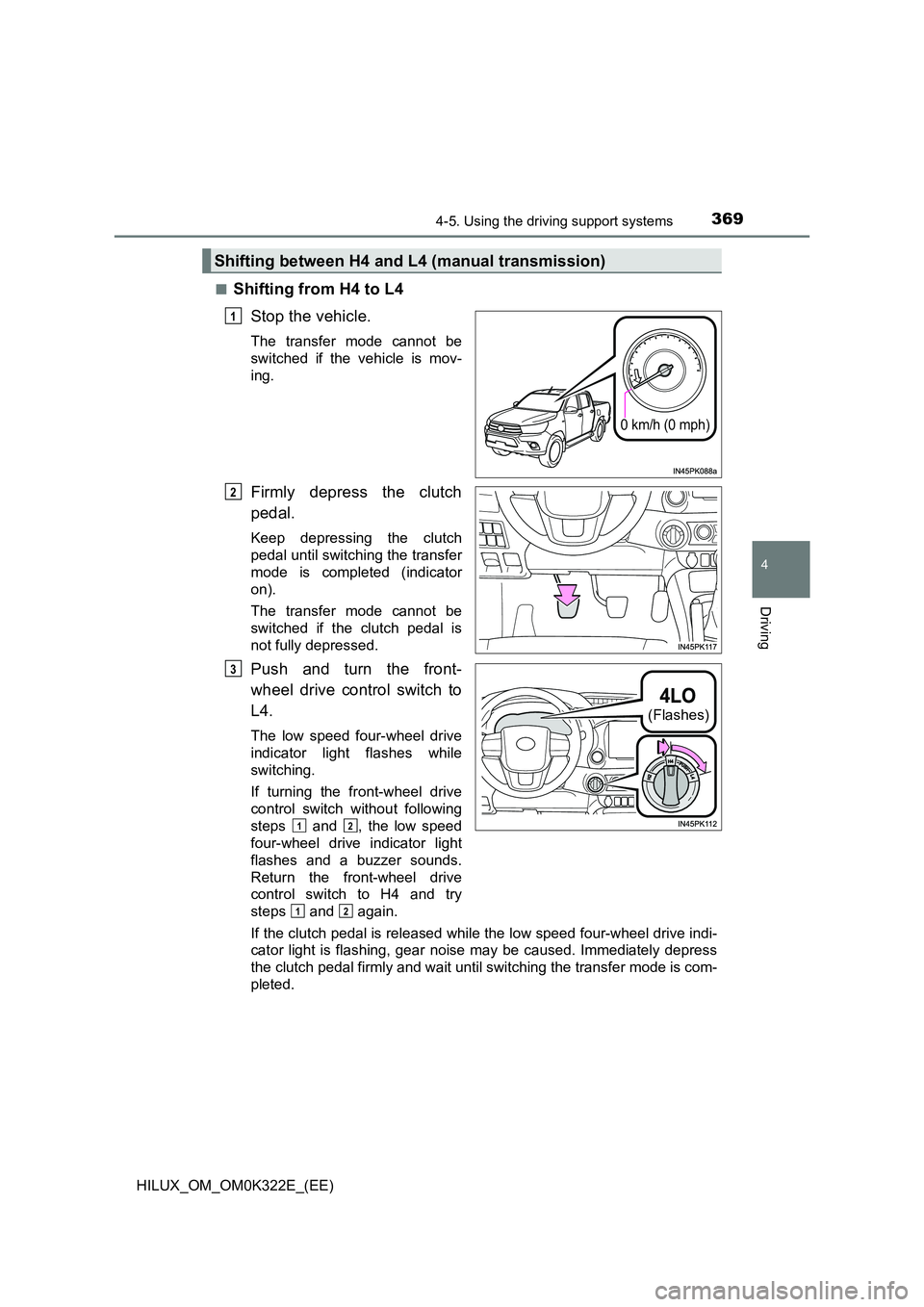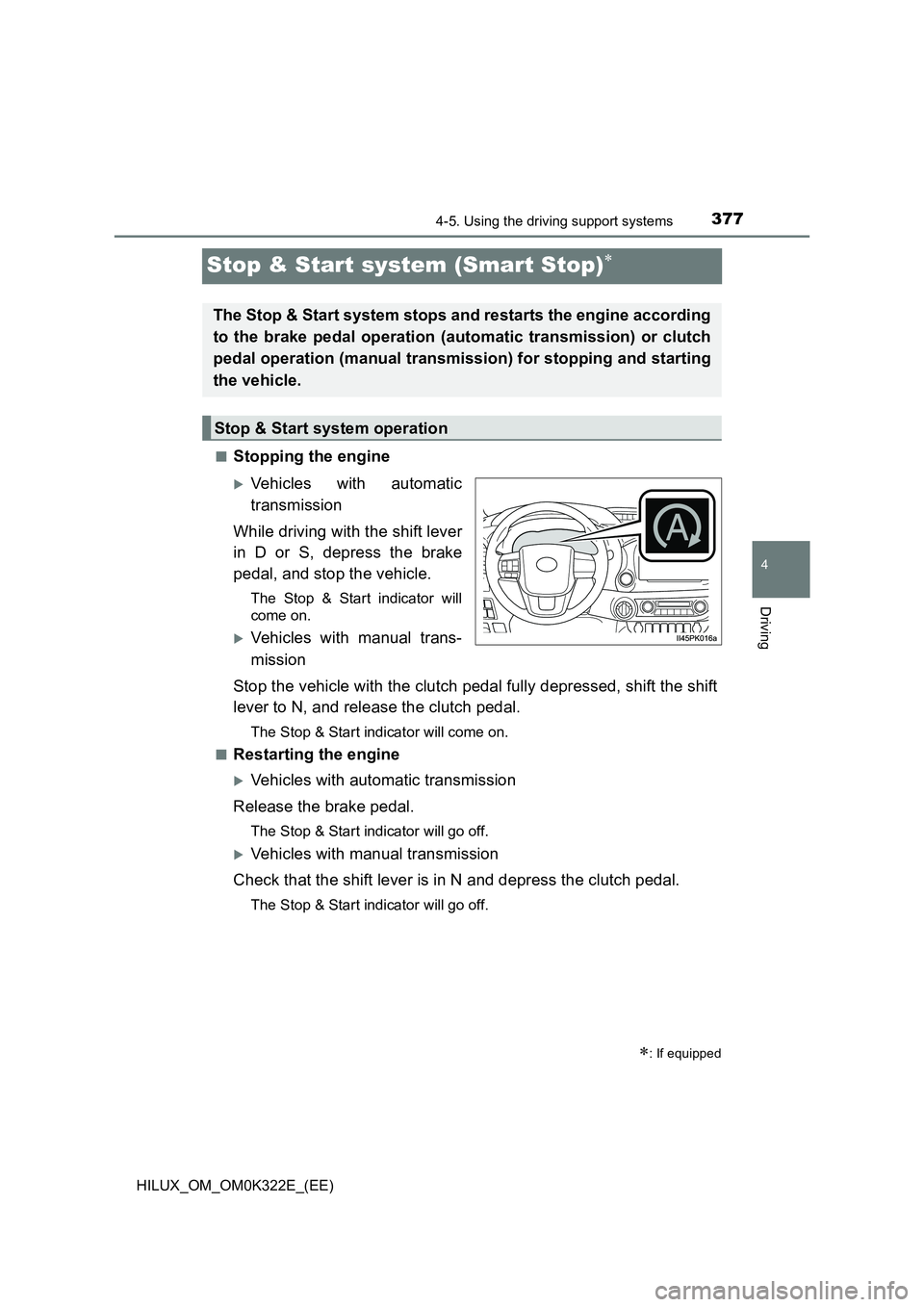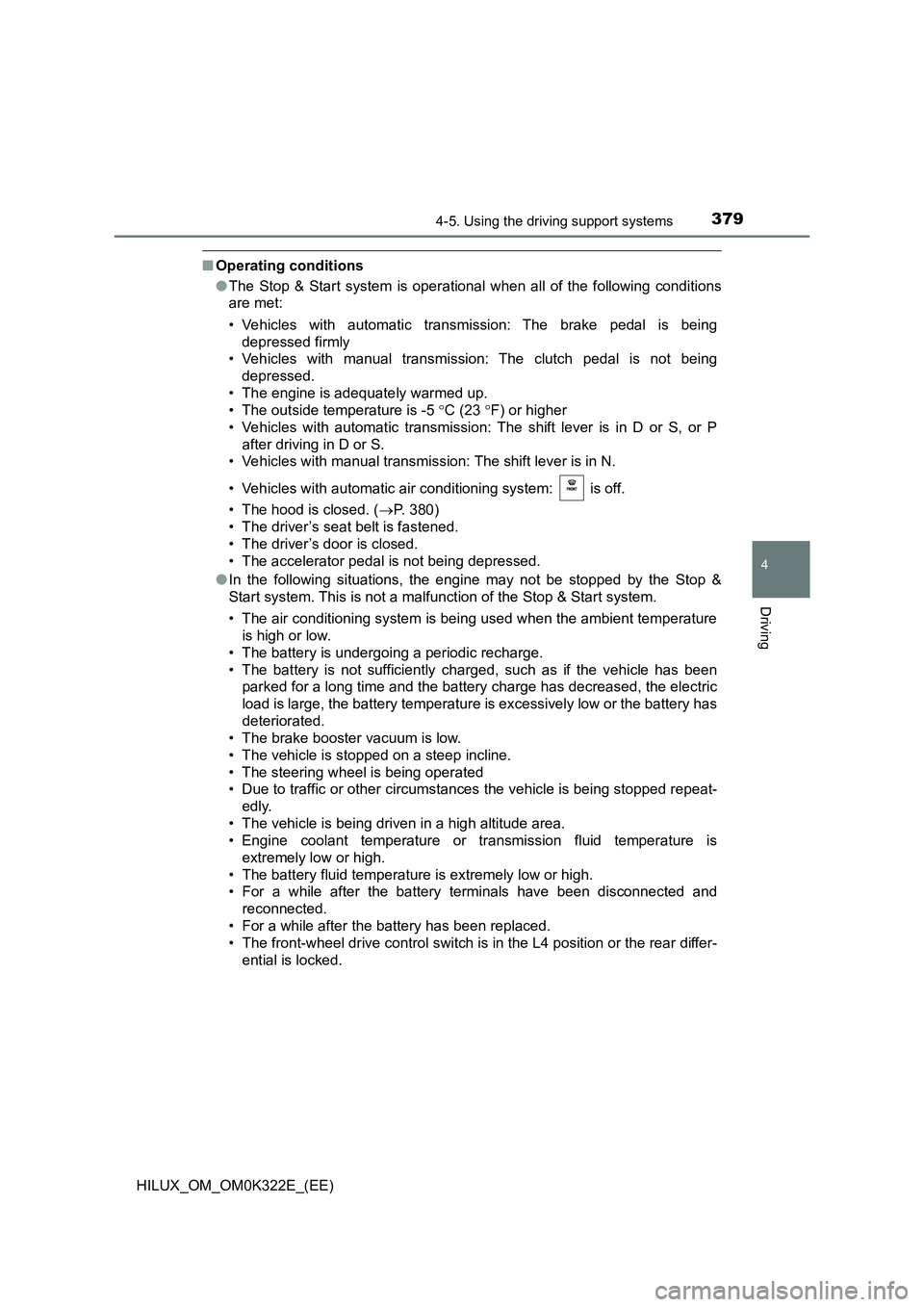Page 275 of 720

2754-2. Driving procedures
4
Driving
HILUX_OM_OM0K322E_(EE)
WARNING
■When starting the engine
Always start the engine while sitting in the driver’s seat. Do not depress the
accelerator pedal while starting the engine under any circumstances.
Doing so may cause an accident resulting in death or serious injury.
■ Caution while driving
If engine failure occurs while the vehicle is moving, do not lock or open the
doors until the vehicle reaches a safe and complete stop. Activation of the
steering lock in this circumstance may lead to an accident, resulting in
death or serious injury.
■ Stopping the engine in an emergency
● If you want to stop the engine in an emergency while driving the vehicle,
press and hold the engine switch for more than 2 seconds, or press it
briefly 3 times or more in succession. ( P. 601)
However, do not touch the engine switch while driving except in an emer-
gency. If the engine switch is pressed while the vehicle is moving, the
warning message “PUSH AND HOLD ENGINE SWITCH FOR EMER-
GENCY STOP”/“Push and hold engine switch for emergency stop” is dis-
played on the multi-information display and a buzzer sounds. Turning the
engine off while driving will not cause loss of steering or braking control,
but the power assist to these systems will be lost. This will make it more
difficult to steer and brake, so you should pull over and stop the vehicle as
soon as it is safe to do so.
● To restart the engine after turning off the engine while driving, shift the shift
lever to N (automatic transmission) or depress the clutch pedal (manual
transmission) and then press the engine switch.
Page 284 of 720
2844-2. Driving procedures
HILUX_OM_OM0K322E_(EE)
Manual transmission
5-speed transmission
Fully depress the clutch pedal
before operating the shift lever,
and then release it slowly.
If it is difficult to shift in reverse,
shift the shift lever to N, release the
clutch pedal momentarily, and then
try again.
6-speed transmission
Fully depress the clutch pedal
before operating the shift lever,
and then release it slowly.
: If equipped
Shifting the shift lever
Page 349 of 720

3494-5. Using the driving support systems
4
Driving
HILUX_OM_OM0K322E_(EE)
To change the set speed, operate the lever until the desired set speed
is obtained.
Increases the speed
Decreases the speed
Fine adjustment: Momentarily
move the lever in the desired direc-
tion.
Large adjustment: Hold the lever in
the desired direction.
The set speed will be increased or decreased as follows:
Fine adjustment: By approximately 1.6 km/h (1 mph) each time the lever is
operated.
Large adjustment: The set speed can be increased or decreased continu-
ally until the lever is released.
Pulling the lever toward you
cancels the constant speed
control.
The speed setting is also canceled
when the brakes are applied or the
clutch pedal (manual transmission
only) is depressed.
Pushing the lever up resumes
the constant speed control.
Resuming is available when the vehicle speed is more than approximately
40 km/h (25 mph).
Adjusting the set speed
1
2
Canceling and resuming the constant speed control
1
2
Page 369 of 720

3694-5. Using the driving support systems
4
Driving
HILUX_OM_OM0K322E_(EE)
■Shifting from H4 to L4
Stop the vehicle.
The transfer mode cannot be
switched if the vehicle is mov-
ing.
Firmly depress the clutch
pedal.
Keep depressing the clutch
pedal until switching the transfer
mode is completed (indicator
on).
The transfer mode cannot be
switched if the clutch pedal is
not fully depressed.
Push and turn the front-
wheel drive control switch to
L4.
The low speed four-wheel drive
indicator light flashes while
switching.
If turning the front-wheel drive
control switch without following
steps and , the low speed
four-wheel drive indicator light
flashes and a buzzer sounds.
Return the front-wheel drive
control switch to H4 and try
steps and again.
If the clutch pedal is released while the low speed four-wheel drive indi-
cator light is flashing, gear noise may be caused. Immediately depress
the clutch pedal firmly and wait until switching the transfer mode is com-
pleted.
Shifting between H4 and L4 (manual transmission)
0 km/h (0 mph)
1
2
(Flashes)
3
12
12
Page 370 of 720
3704-5. Using the driving support systems
HILUX_OM_OM0K322E_(EE)
Check that the low speed
four-wheel drive indicator
light comes on.
The low speed four-wheel drive
indicator light comes on when
switching the transfer mode is
completed.
Release the clutch pedal to
drive the vehicle.
■Shifting from L4 to H4
Stop the vehicle.
The transfer mode cannot be
switched if the vehicle is mov-
ing.
Firmly depress the clutch
pedal.
Keep depressing the clutch
pedal until switching the transfer
mode is completed (indicator
off).
The transfer mode cannot be
switched if the clutch pedal is
not fully depressed.
(Comes on)
4
0 km/h (0 mph)
1
2
Page 371 of 720

3714-5. Using the driving support systems
4
Driving
HILUX_OM_OM0K322E_(EE)
Turn the front-wheel drive
control switch to H4.
The low speed four-wheel drive
indicator light flashes while
switching.
If turning the front-wheel drive
control switch without following
steps and , the low speed
four-wheel drive indicator light
flashes and a buzzer sounds.
Return the front-wheel drive
control switch to L4 and try
steps and again.
If the clutch pedal is released while the low speed four-wheel drive indi-
cator light is flashing, gear noise may be caused. Immediately depress
the clutch pedal firmly and wait until switching the transfer mode is com-
pleted.
Check that the low speed
four-wheel drive indicator
light goes off.
The low speed four-wheel drive
indicator light goes off when
switching the transfer mode is
completed.
Release the clutch pedal to
drive the vehicle.
(Flashes)
3
12
12
(Goes off)
4
NOTICE
■ Shifting between H4 and L4
Do not release the clutch pedal or depress the accelerator pedal while the
low speed four-wheel drive indicator light is flashing. Failure to do so may
cause gear noise and result in a malfunction.
Page 377 of 720

377
4
4-5. Using the driving support systems
Driving
HILUX_OM_OM0K322E_(EE)
Stop & Start system (Smart Stop)
■Stopping the engine
Vehicles with automatic
transmission
While driving with the shift lever
in D or S, depress the brake
pedal, and stop the vehicle.
The Stop & Start indicator will
come on.
Vehicles with manual trans-
mission
Stop the vehicle with the clutch pedal fully depressed, shift the shift
lever to N, and release the clutch pedal.
The Stop & Start indicator will come on.
■Restarting the engine
Vehicles with automatic transmission
Release the brake pedal.
The Stop & Start indicator will go off.
Vehicles with manual transmission
Check that the shift lever is in N and depress the clutch pedal.
The Stop & Start indicator will go off.
: If equipped
The Stop & Start system stops and restarts the engine according
to the brake pedal operation (automatic transmission) or clutch
pedal operation (manual transmission) for stopping and starting
the vehicle.
Stop & Start system operation
Page 379 of 720

3794-5. Using the driving support systems
4
Driving
HILUX_OM_OM0K322E_(EE)
■Operating conditions
● The Stop & Start system is operational when all of the following conditions
are met:
• Vehicles with automatic transmission: The brake pedal is being
depressed firmly
• Vehicles with manual transmission: The clutch pedal is not being
depressed.
• The engine is adequately warmed up.
• The outside temperature is -5 C (23 F) or higher
• Vehicles with automatic transmission: The shift lever is in D or S, or P
after driving in D or S.
• Vehicles with manual transmission: The shift lever is in N.
• Vehicles with automatic air conditioning system: is off.
• The hood is closed. ( P. 380)
• The driver’s seat belt is fastened.
• The driver’s door is closed.
• The accelerator pedal is not being depressed.
● In the following situations, the engine may not be stopped by the Stop &
Start system. This is not a malfunction of the Stop & Start system.
• The air conditioning system is being used when the ambient temperature
is high or low.
• The battery is undergoing a periodic recharge.
• The battery is not sufficiently charged, such as if the vehicle has been
parked for a long time and the battery charge has decreased, the electric
load is large, the battery temperature is excessively low or the battery has
deteriorated.
• The brake booster vacuum is low.
• The vehicle is stopped on a steep incline.
• The steering wheel is being operated
• Due to traffic or other circumstances the vehicle is being stopped repeat-
edly.
• The vehicle is being driven in a high altitude area.
• Engine coolant temperature or tr ansmission fluid temperature is
extremely low or high.
• The battery fluid temperature is extremely low or high.
• For a while after the battery terminals have been disconnected and
reconnected.
• For a while after the battery has been replaced.
• The front-wheel drive control switch is in the L4 position or the rear differ-
ential is locked.